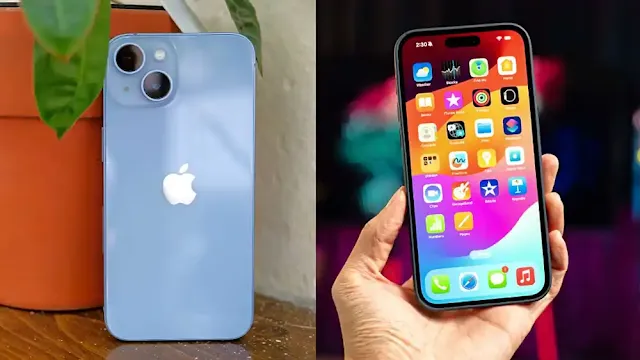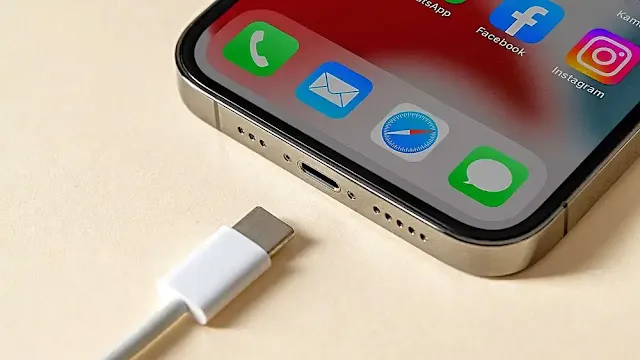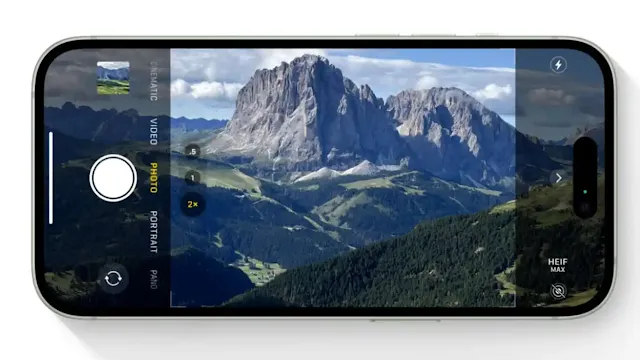Apple iPhone 15 vs. Apple iPhone 14: Specifications, Camera, Features, and More
Apple
continues to captivate consumers with its iconic
iPhone
lineup. While the Pro models garner significant attention, the vanilla
iPhone models have their dedicated user base.
Apple's commitment to producing high-quality devices, both in terms of
hardware and software, has led to extended upgrade cycles for
iPhones.
In this article, we aim to provide an unbiased, detailed comparison between
the Apple iPhone 15 (review) and its predecessor, the iPhone 14, both of which are still available for
purchase.
iPhone 15 vs. iPhone 14 Comparison:
| Feature | iPhone 15 | iPhone 14 |
|---|---|---|
| Display Size | 6.1 inches | 6.1 inches |
| Display Resolution | 1179 x 2556 pixels | 1170 x 2532 pixels |
| Main Camera | 48MP | 12MP |
| USB Port | USB Type-C | Lightning |
| Battery Capacity | 3349 mAh | 3279 mAh |
| Processor | A16 Bionic | A15 Bionic |
| Operating System | iOS 15 | iOS 14 |
| Charging Speed | Fast Charging | Fast Charging |
| Speaker Performance | Good | Very Good |
| Display Brightness | 1643 nits | 804 nits |
| Water Resistance | IP68 | IP68 |
| Software Support | Longer Updates | Standard Updates |
| Available on | Amazon | Flipkart |
Design and Size:
At first glance, the iPhone 15 and iPhone 14 share a strikingly similar physical footprint, making them nearly indistinguishable in terms of size and shape.
However, subtle differences come to light upon closer examination. The
iPhone 15 stands out with its new colors and the adoption of the Dynamic
Island, previously exclusive to the Pro models, giving it a more
contemporary appearance.
Both phones sport a 6.1-inch display, with the iPhone 15 boasting a slightly higher resolution and an improved screen-to-body ratio of around 86.4%.
While the difference in resolution is hardly noticeable, the iPhone 15's
rounded chamfer on its aluminum middle frame enhances handling comfort.
Materials and Build:
Both the iPhone 15 and iPhone 14 feature aluminum frames, Gorilla Glass on the back, and a Ceramic Shield on the front, providing durability and protection.
Additionally, both models carry the same IP68 rating, certifying their
ability to withstand submersion in up to 6 meters of fresh water for 30
minutes.
Display:
The display is a key element of any smartphone, and while both the iPhone 15 and iPhone 14 feature 6.1-inch Super Retina XDR OLED displays certified for HDR10 and Dolby Vision, there are notable differences. Regrettably, Apple has continued to limit the refresh rate of its vanilla iPhone models to 60Hz.However, the iPhone 15 distinguishes itself with a significant improvement in brightness. It reaches 1643 nits of maximum brightness when exposed to strong external light, whereas the iPhone 14 maxes out at 804 nits.
The slightly higher resolution of the iPhone 15's display (1179 x 2556
pixels) compared to the iPhone 14 (1170 x 2532 pixels) is hardly
perceptible, but the transition from the notch design to the Dynamic Island
on the iPhone 15 brings it in line with the Pro models, offering a more
modern look.
Battery Life:
Apple has managed to fit a slightly larger battery into the iPhone 15, increasing its capacity from 3279 mAh (iPhone 14) to 3349 mAh, without altering the device's dimensions or weight.
Furthermore, the A16 Bionic chip inside the iPhone 15 is based on a more
efficient 4nm process compared to the A15 Bionic (5nm) found in the iPhone
14.
Combined with architectural advancements and likely improved display
efficiency, this results in a noticeable bump in battery endurance.
In testing, the iPhone 15 outperformed the iPhone 14, achieving an overall battery endurance of 98 hours compared to the iPhone 14's 90 hours.
In testing, the iPhone 15 outperformed the iPhone 14, achieving an overall battery endurance of 98 hours compared to the iPhone 14's 90 hours.
Particularly, the iPhone 15 demonstrated longer runtimes during on-screen
tasks such as web browsing and video watching, essential aspects of battery
endurance.
Charging Speed:
Both the iPhone 14 and iPhone 15 are equipped to charge from zero to 50% in just 30 minutes with a 20W charger, according to Apple's claims.
In real-world testing, both models exceeded this expectation, with the
iPhone 14 reaching 60% and the iPhone 15 hitting approximately 58% in half
an hour.
While neither phone can be considered particularly fast in terms of charging, the iPhone 14 has a charging taper-off that is less aggressive towards the end of the cycle compared to the iPhone 15.
Consequently, the iPhone 14 manages to complete a full charge slightly
faster, taking 1 hour and 31 minutes, compared to the iPhone 15's 1 hour and
50 minutes.
It's worth noting that charging curve behavior could change with future iOS
updates.
Speaker Quality:
Both the iPhone 14 and iPhone 15 feature hybrid stereo speaker setups, combining a dedicated bottom-firing speaker with an amplified earpiece.
These setups deliver excellent sound quality, characterized by clean mids
and highs and even some lows.
While the exact reason for this difference is speculative, it's worth
noting that the iPhone 14 achieved a "VERY GOOD" score in loudness, while
the iPhone 15 earned a "GOOD" rating.
Performance:
The heart of any smartphone is its processor, and both the iPhone 14 and iPhone 15 house powerful Apple-designed chips.
The iPhone 14 features the A15 Bionic chip built on a 5nm process, while
the iPhone 15 boasts the newer A16 Bionic chip fabricated using a more
efficient 4nm process.
The CPU performance improvements of the A16 over the A15 are incremental,
but the move to LPDDR5 RAM provides a substantial boost in overall
performance and responsiveness.
In the GPU department, both models have five GPU cores, benefiting from the higher memory bandwidth available on the A16 chipset.
In the GPU department, both models have five GPU cores, benefiting from the higher memory bandwidth available on the A16 chipset.
Apple's Neural Engine, responsible for on-board machine learning tasks, is
also similar in both models, boasting increased performance on the A16
chip.
In practical terms, the A16 is approximately 15% more powerful than the
A15.
Camera Capabilities:
The camera systems in the iPhone 14 and iPhone 15 differ significantly, with the iPhone 15 introducing an all-new 48MP main camera.
Utilizing computational photography and stacking techniques, the iPhone 15
produces 24MP stills that offer greater detail than the 12MP cameras on
previous iPhones, thanks to an enhanced version of Apple's Photonic
Engine.
While the iPhone 15 lacks a dedicated optical zoom camera, its high-resolution main camera allows for high-quality digital crops and zooms, potentially surpassing the iPhone 14 in this regard.
Both models share a 12MP ultrawide camera on the back, lacking features
like autofocus found on the Pro models.
The selfie cameras on both models are likely identical, with 12MP sensors and autofocus capabilities.
The selfie cameras on both models are likely identical, with 12MP sensors and autofocus capabilities.
The iPhone 15's 24MP default photos from the main camera exhibit
exceptional sharpness and detail, while the 2x digital zoomed photos also
benefit from the higher main camera resolution.
The color processing and science developed by Apple over the years remain consistent on both phones, offering slightly more muted colors compared to many modern Android phones, catering to individual preferences.
The color processing and science developed by Apple over the years remain consistent on both phones, offering slightly more muted colors compared to many modern Android phones, catering to individual preferences.
Both models excel in video capture, offering up to 4K resolution across all cameras with optional EIS and expanded dynamic range through Smart HDR and HDR video capture. ProRes video remains exclusive to the iPhone Pro models.
In low-light scenarios, both the iPhone 15 and iPhone 14 deliver impressive results, with a slight edge given to the iPhone 15.
One notable drawback in Apple's night mode is the inability to manually activate it; users can only toggle it off.
Additionally, in default Auto mode, the Night mode may not activate as
frequently as desired, a criticism applicable to both models.
Verdict:
The iPhone 15 and iPhone 14 each cater to distinct consumer preferences and priorities. The iPhone 14, being more budget-friendly, retainsits relevance in 2023, offering fast charging, slightly louder speakers, and competitive hardware.
On the other hand, the iPhone 15 introduces several enhancements, including
a superior 48MP main camera, USB Type-C connectivity, a brighter display,
improved battery life, and a faster chipset.
Ultimately, the choice between these two models depends on individual needs and preferences.
Ultimately, the choice between these two models depends on individual needs and preferences.
The iPhone 15 presents a compelling option for those seeking the latest
features and longer software support.
However, the iPhone 14 continues to provide an excellent smartphone
experience at a more accessible price point.
Apple's decision to offer both models ensures a diverse range of choices
for consumers, catering to both the tech-savvy and those seeking
simplicity.
FAQs:
Q: What are the differences between the iPhone 15 and iPhone 14?
The iPhone 15 boasts a brighter display, a superior 48MP camera, USB Type-C connectivity, and improved battery life compared to the iPhone 14.
Q: Is the size and shape of the iPhone 15 and iPhone 14 identical?
Yes, both phones share an almost identical size and shape.
Q: Are there any design improvements in the iPhone 15?
Yes, the iPhone 15 features a more modern appearance with new colors and the introduction of the Dynamic Island design element.
Q: How do the display specifications of the iPhone 15 and iPhone 14 differ?
While both have 6.1-inch Super Retina XDR OLED displays, the iPhone 15 offers notably higher brightness levels and a slightly higher resolution.
Q: Which iPhone charges faster, the 14 or the 15?
The iPhone 14 charges slightly faster to 100% compared to the iPhone 15, despite both models exceeding Apple's claimed charging speeds.
Q: How do the speaker qualities of the iPhone 15 and iPhone 14 compare?
The iPhone 14 offers slightly louder speakers, earning a "VERY GOOD" rating, while the iPhone 15 achieves a "GOOD" rating.
Q: Are there significant performance differences between the A16 and A15 Bionic chips?
The A16 chip in the iPhone 15 offers approximately 15% more power than the A15, thanks to architectural advancements and LPDDR5 RAM.
Q: What camera enhancements does the iPhone 15 bring over the iPhone 14?
The iPhone 15 introduces a 48MP main camera, enabling high-quality digital crops and zooms, outperforming the 12MP camera on the iPhone 14.
Q: Do both iPhones excel in low-light photography?
Yes, both models perform well in low-light conditions, with a slight edge going to the iPhone 15.
Q: Can I manually activate Night mode on both the iPhone 15 and iPhone 14?
No, you can only toggle Night mode off; it doesn't have a manual activation option on either model.
Q: Which iPhone is more budget-friendly, the 14 or the 15?
The iPhone 14 is more budget-friendly and still offers competitive hardware.
Q: Does the iPhone 15 offer longer software support?
Yes, the iPhone 15 is likely to receive longer software updates.
Q: What is the significance of the USB Type-C port on the iPhone 15?
The iPhone 15's adoption of the USB Type-C port marks a shift in iPhone history, offering users a more universal and versatile connectivity option.
Q: Which iPhone model should I choose, the 15 or the 14?
Your choice depends on your specific needs and preferences. The iPhone 15 is ideal for those seeking the latest features, while the iPhone 14 offers an excellent smartphone experience at a more accessible price point.
The iPhone 15 boasts a brighter display, a superior 48MP camera, USB Type-C connectivity, and improved battery life compared to the iPhone 14.
Q: Is the size and shape of the iPhone 15 and iPhone 14 identical?
Yes, both phones share an almost identical size and shape.
Q: Are there any design improvements in the iPhone 15?
Yes, the iPhone 15 features a more modern appearance with new colors and the introduction of the Dynamic Island design element.
Q: How do the display specifications of the iPhone 15 and iPhone 14 differ?
While both have 6.1-inch Super Retina XDR OLED displays, the iPhone 15 offers notably higher brightness levels and a slightly higher resolution.
Q: Which iPhone charges faster, the 14 or the 15?
The iPhone 14 charges slightly faster to 100% compared to the iPhone 15, despite both models exceeding Apple's claimed charging speeds.
Q: How do the speaker qualities of the iPhone 15 and iPhone 14 compare?
The iPhone 14 offers slightly louder speakers, earning a "VERY GOOD" rating, while the iPhone 15 achieves a "GOOD" rating.
Q: Are there significant performance differences between the A16 and A15 Bionic chips?
The A16 chip in the iPhone 15 offers approximately 15% more power than the A15, thanks to architectural advancements and LPDDR5 RAM.
Q: What camera enhancements does the iPhone 15 bring over the iPhone 14?
The iPhone 15 introduces a 48MP main camera, enabling high-quality digital crops and zooms, outperforming the 12MP camera on the iPhone 14.
Q: Do both iPhones excel in low-light photography?
Yes, both models perform well in low-light conditions, with a slight edge going to the iPhone 15.
Q: Can I manually activate Night mode on both the iPhone 15 and iPhone 14?
No, you can only toggle Night mode off; it doesn't have a manual activation option on either model.
Q: Which iPhone is more budget-friendly, the 14 or the 15?
The iPhone 14 is more budget-friendly and still offers competitive hardware.
Q: Does the iPhone 15 offer longer software support?
Yes, the iPhone 15 is likely to receive longer software updates.
Q: What is the significance of the USB Type-C port on the iPhone 15?
The iPhone 15's adoption of the USB Type-C port marks a shift in iPhone history, offering users a more universal and versatile connectivity option.
Q: Which iPhone model should I choose, the 15 or the 14?
Your choice depends on your specific needs and preferences. The iPhone 15 is ideal for those seeking the latest features, while the iPhone 14 offers an excellent smartphone experience at a more accessible price point.
Q: How do the iPhone 15 and iPhone 14 differ in terms of design?
While they share a similar size, the iPhone 15 stands out with new colors, a Dynamic Island, and a rounded chamfer for improved handling.
While they share a similar size, the iPhone 15 stands out with new colors, a Dynamic Island, and a rounded chamfer for improved handling.
Q: Is there a significant disparity in display quality between the iPhone
15 and iPhone 14?
Yes, the iPhone 15 boasts a considerably brighter display, offering 1643 nits of maximum brightness, compared to the iPhone 14's 804 nits.
Yes, the iPhone 15 boasts a considerably brighter display, offering 1643 nits of maximum brightness, compared to the iPhone 14's 804 nits.









